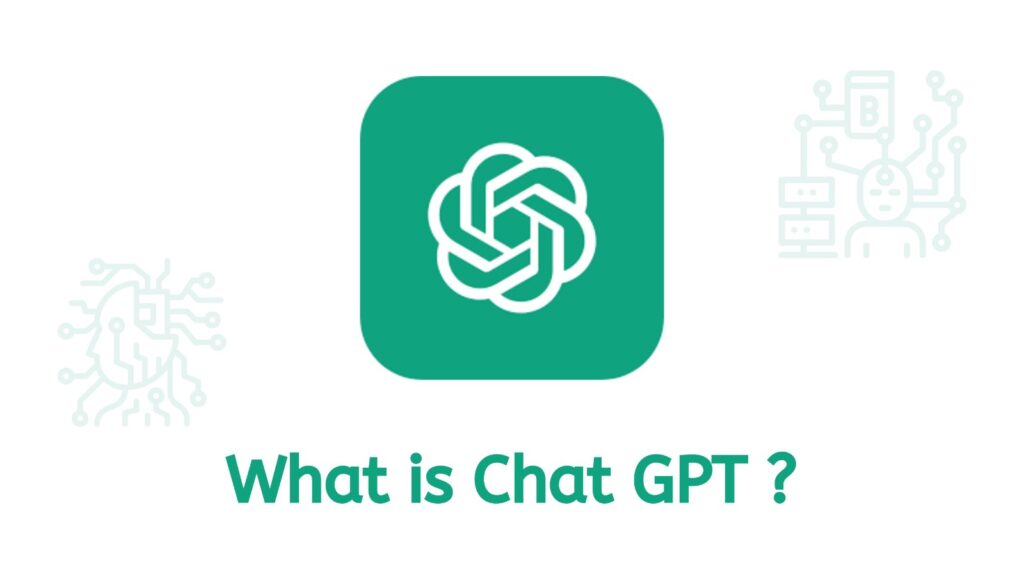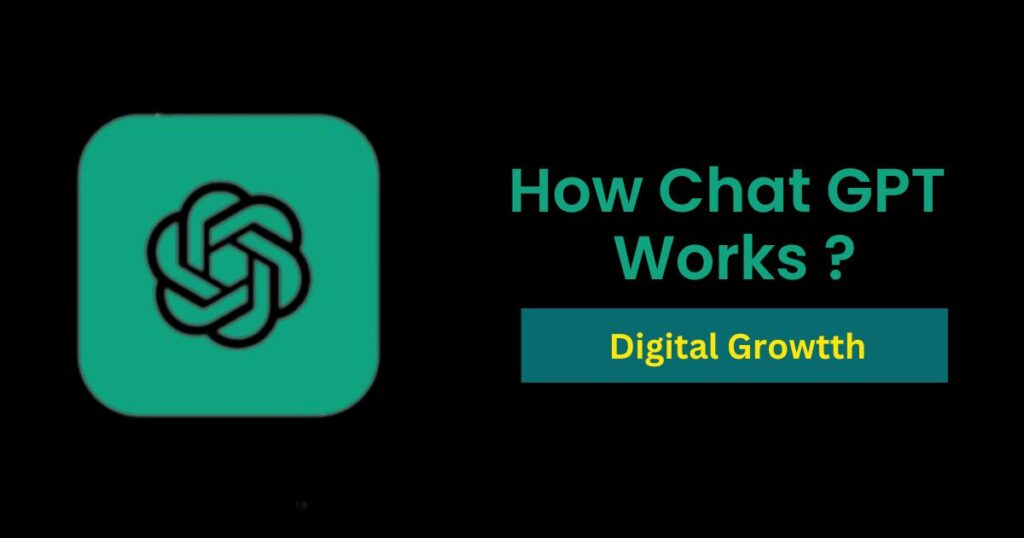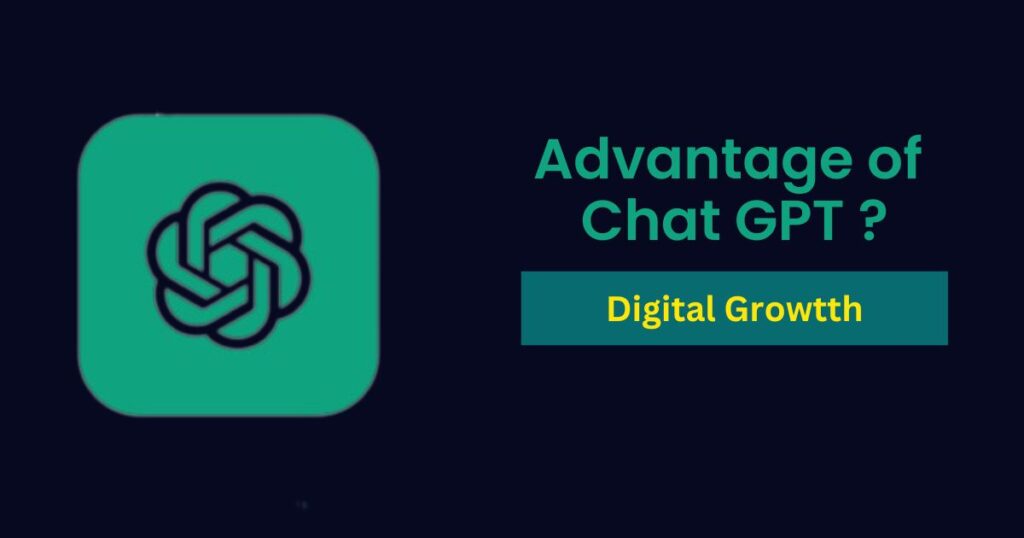What is ChatGPT ?

The Best Answers for What is chatGPT ? – ChatGPT, also known as Generative Pre-trained Transformer, is a type of chatbot that utilizes artificial intelligence (AI) and natural language processing (NLP) to provide human-like conversations. The chatbot is trained on vast amounts of data and can respond to questions and requests in real-time.
ChatGPT has become increasingly important in recent years due to its ability to provide enhanced customer experiences, improved accuracy and responsiveness, and cost and time savings. This technology is also becoming increasingly relevant in various industries such as customer service, marketing and sales, education and training, and healthcare.

What is ChatGPT and History of ChatGPT

Evolution of Chatbots
The evolution of chatbots can be traced back to the 1960s when the first chatbot, ELIZA, was created by Joseph Weizenbaum. Since then, chatbots have continued to evolve and have become increasingly sophisticated.
The Emergence of ChatGPT
The first version of GPT (Generative Pre-trained Transformer) was introduced in 2018 by OpenAI. The chatbot was trained on vast amounts of data and demonstrated an ability to generate human-like responses in real-time.
Advancements in ChatGPT Technology
Since its introduction, GPT has continued to evolve and has become increasingly sophisticated. Advancements in AI and NLP have led to the development of more advanced chatGPT systems that are able to provide improved accuracy and responsiveness.
What is ChatGPT and How ChatGPT Works ?

You Make Like : 15 Creative ways to Make Money with ChatGPT 2023
The Architecture of ChatGPT
ChatGPT is based on a neural network architecture known as the Transformer. This architecture is designed to process sequential data, such as text, and is trained on vast amounts of data to generate human-like responses.
Understanding the Power of Natural Language Processing with ChatGPT
Natural Language Processing is a key component of chatGPT and is responsible for enabling the chatbot to understand and respond to human language. The chatbot is trained on vast amounts of data and uses this information to understand and respond to questions and requests in real-time.
The Role of Neural Networks in ChatGPT
ChatGPT utilizes neural networks to process and analyze the vast amounts of data it is trained on. The neural networks are designed to recognize patterns in the data and use this information to generate human-like responses. The neural networks are also designed to learn and improve over time, leading to increased accuracy and responsiveness.
What is ChatGPT and Advantages of ChatGPT

Enhanced Customer Experience
Now You know what is ChatGPT and How ChatGPT can provide an enhanced customer experience by providing immediate and accurate responses to questions and requests. The technology is designed to understand and respond to human language, providing a more natural and conversational experience.
Improved Accuracy and Responsiveness
ChatGPT is trained on vast amounts of data, leading to improved accuracy and responsiveness. The technology is also designed to learn and improve over time, leading to even more accurate and responsive results.
Cost and Time Savings
ChatGPT can provide cost and time savings by automating repetitive and time-consuming tasks. This technology can handle multiple conversations at the same time, leading to increased efficiency and decreased costs.
What is ChatGPT and Applications of ChatGPT
Customer Service
ChatGPT is increasingly being used in customer service to provide immediate and accurate responses to customer inquiries. The technology is designed to understand and respond to human language, providing a more natural and conversational experience.
Marketing and Sales
ChatGPT is also being used in marketing and sales to provide customers with information about products and services. The technology can be trained on specific data related to the products and services being offered, leading to more accurate and relevant responses.
Education and Training
ChatGPT is being used in education and training to provide students with immediate and accurate responses to questions and requests. The technology is designed to understand and respond to human language, making the learning experience more natural and conversational.
Healthcare
ChatGPT is also being used in healthcare to provide patients with information about medical conditions and treatments. The technology can be trained on specific medical data, leading to more accurate and relevant responses.
What are Challenges of ChatGPT
Complexity in Implementation
ChatGPT can be complex to implement, especially for businesses that are new to the technology. This can lead to difficulties in integrating the technology into existing systems and processes.
Data Privacy Concerns
There are also data privacy concerns associated with chatGPT. Businesses need to ensure that the vast amounts of data used to train the technology is protected and not misused.
Limited Human Emotion
ChatGPT is limited in its ability to understand and respond to human emotions. This can lead to limitations in the technology’s ability to provide a truly human-like experience.
Future of ChatGPT
Advancements in AI and NLP
The Future of ChatGPT is expected to be influenced by advancements in AI and NLP. These advancements will lead to more sophisticated and advanced chatbots that can provide even more enhanced customer experiences and to Unlock The Power of Natural Language Processing with ChatGPT
Integration with other Technologies
ChatGPT is also expected to be integrated with other technologies, such as voice assistants, to provide even more advanced and sophisticated experiences.
The Potential for Enhanced Customer Experience
The future of chatGPT holds the potential for enhanced customer experiences by providing immediate and accurate responses to questions and requests. The technology is expected to become even more human-like and natural, leading to more personalized and conversational experiences.
Conclusion on What is ChatGPT
Summary of Key Points on What is ChatGPT
ChatGPT is a type of chatbot that utilizes AI and NLP to provide human-like responses to customer inquiries. You can use chatGPT on Mobile and it is free to use chatGPT for now. The technology is trained on vast amounts of data, leading to improved accuracy and responsiveness. It offers several advantages, including enhanced customer experience, cost and time savings, and the ability to handle multiple conversations at once. However, there are also challenges to implementing chatGPT, such as complexity and data privacy concerns.
Final Thoughts on What is ChatGPT ?
ChatGPT has the potential to revolutionize the customer service industry by providing immediate and accurate responses to customer inquiries. As AI and NLP continue to advance, the technology is expected to become even more sophisticated and human-like, leading to even more enhanced customer experiences. Businesses that adopt chat GPT can expect to see improved efficiency, cost savings, and happier customers.
In conclusion, chatGPT is a technology worth considering for businesses that are looking to improve their customer service operations. With its ability to provide enhanced customer experiences, improved accuracy, and cost and time savings, it is a technology that has the potential to revolutionize the way we interact with businesses.
Read More About What is ChatGPT and Upcoming News About ChatGPT Must Visit www.digitalgrowtth.com
- How to use ChatGPT : Step by Step Guide
- Future of AI : ChatGPT and its Impact on Society
- Unlock The Power of Natural Language Processing with ChatGPT
- ChatGPT vs BARD – 7 Key Differences between OpenAI’s Chat GPT vs Google’s Bard Which is Better to use ?
- Future of ChatGPT: The Future of Conversational AI
- Air Conditioned Shoes : Say Goodbye to Hot and Sweaty Feet Forever
FAQ’s – Frequently Asked Question
-
How ChatGPT is Trained ?
ChatGPT is a state-of-the-art language model developed by OpenAI. It is based on the transformer architecture and was trained using a deep learning technique called unsupervised learning.
In unsupervised learning, the model is trained on large amounts of text data without explicit human annotations. The model uses this data to learn patterns and relationships in the language.
The training process for ChatGPT involves the following steps:
Pre-processing: The text data is pre-processed and tokenized into a numerical representation.
Model architecture: The transformer architecture is used to build the ChatGPT model. This architecture is composed of an encoder and a decoder, which are trained to map input sequences to output sequences.
Training: The model is trained on large amounts of text data using a variant of the transformer architecture known as the transformer-XL architecture. During training, the model is fed a sequence of tokens and is trained to predict the next token in the sequence.
Fine-tuning: Once the model has been trained, it can be fine-tuned on specific tasks, such as answering questions or generating text, by providing it with additional task-specific data and adjusting its parameters accordingly.
The training process for ChatGPT is computationally intensive and requires significant computational resources, including GPUs. The model is trained on billions of words of text data, which can take several days to process. -
Where Chatgpt get data from ?
ChatGPT is trained on a diverse range of text data sources, including web pages, books, and other text-based sources. This text data is used to train the model to understand the patterns and relationships in human language.
OpenAI, the developers of ChatGPT, obtain this text data from publicly available sources, such as the Common Crawl dataset, which is a large-scale web crawl of publicly available web pages, and other text-based sources such as books and articles.
It’s worth noting that the training data used to develop ChatGPT is filtered to remove low-quality or malicious content, but some biases and inaccuracies may still exist in the model’s understanding of language due to the biases present in the training data. OpenAI is continually working to address these issues and improve the quality of the model’s output. -
Can ChatGPT write Essays ?
Yes, ChatGPT can generate text that resembles an essay, but the quality and coherence of the generated text can vary greatly depending on the prompt and the specific use case.
ChatGPT is a language model that has been trained on a large corpus of text data, which enables it to generate text that is similar to the text it was trained on. When generating an essay, it may be able to produce text that follows the structure and conventions of an essay, such as an introduction, body, and conclusion.
However, it’s important to keep in mind that the text generated by ChatGPT is not the result of understanding or analysis, but rather is based on patterns it has learned from the text it was trained on. The generated text may not always be accurate, relevant, or free of errors, and it may not always align with the prompt or intended use case.
If you are looking for a high-quality, well-researched essay, it’s recommended to use a human writer or to perform additional research and editing on the text generated by ChatGPT. -
Can ChatGPT Translate ?
Yes, ChatGPT can be used for machine translation, which involves automatically translating text from one language to another.
To use ChatGPT for machine translation, you would need to fine-tune the model on parallel text data, which is text data that consists of corresponding sentences in two or more languages. The model can then be used to translate new sentences by encoding the source sentence and decoding it into the target language. -
Will ChatGPT always be Free ?
According to ChatGPT, It is uncertain whether ChatGPT will always be free. The availability and cost of using ChatGPT may change in the future, depending on various factors such as the development and growth of OpenAI, the demand for the technology, and the availability of funding and resources.
OpenAI is a private research organization that is funded by investors and partners. The availability and cost of using its technologies, including ChatGPT, will be determined by its business strategy and financial goals.
While OpenAI has stated its goal of making its technologies accessible to as many people as possible, it is possible that some of its services, including access to ChatGPT, may become paid in the future. Additionally, third-party companies and organizations may offer access to ChatGPT or similar models for a fee, either through licensing agreements with OpenAI or by building their own models based on the technology.
In conclusion, it is uncertain whether ChatGPT will always be free, and the availability and cost of using the technology may change in the future. It’s advisable to stay informed about the latest developments and updates from OpenAI and other relevant organizations to get a better understanding of the future of ChatGPT and its availability. -
Are ChatGPT Answers Unique ?
The answers generated by ChatGPT are not necessarily unique, as it is trained on a large corpus of text data and generates responses based on patterns learned from this data. The responses generated by ChatGPT can be similar to other text found in its training data, and multiple instances of ChatGPT may generate similar or identical responses for the same input.
It is important to note that ChatGPT is a language model and not a creative writer, and its responses are limited by the patterns it learned from its training data. While ChatGPT can generate text that is coherent and informative, the responses may not always be original or truly unique.
Additionally, as ChatGPT is a machine learning model, its responses can be influenced by biases present in its training data, and it may not always generate responses that are factually accurate or culturally sensitive. It is important to validate the information generated by ChatGPT before using it, especially in situations where accuracy and reliability are important. -
What ChatGPT can Do?
Some of the most common tasks that ChatGPT can perform include:
Text generation: ChatGPT can generate text based on a prompt or input, creating coherent and grammatically correct sentences and paragraphs. This makes it a powerful tool for tasks such as content creation and writing.
Text completion: ChatGPT can be used to complete text, such as a sentence or paragraph, based on an initial prompt or input. This is useful for tasks such as language translation and text summarization.
Question answering: ChatGPT can be trained to answer questions based on a given context, making it useful for tasks such as chatbots and virtual assistants.
Text classification: ChatGPT can be trained to categorize text into different categories or classes, such as positive, negative, or neutral, making it useful for sentiment analysis and text classification tasks.
Dialogue generation: ChatGPT can generate natural language responses in a conversational setting, making it useful for chatbots and virtual assistants.
These are just a few examples of the many tasks that ChatGPT can perform. As a powerful language model, ChatGPT is capable of a wide range of natural language processing tasks, and its capabilities continue to expand as research in the field advances. -
What ChatGPT stands for ?
The acronym “GPT” in ChatGPT stands for “Generative Pre-trained Transformer”.
A transformer is a type of artificial neural network architecture that is commonly used for natural language processing tasks. In the context of ChatGPT, the “generative” part refers to the model’s ability to generate text, while the “pre-trained” part refers to the fact that the model has been trained on a large corpus of text data before being made available for use.
Now, You can use ChatGPT. Just Click on Below Button .



